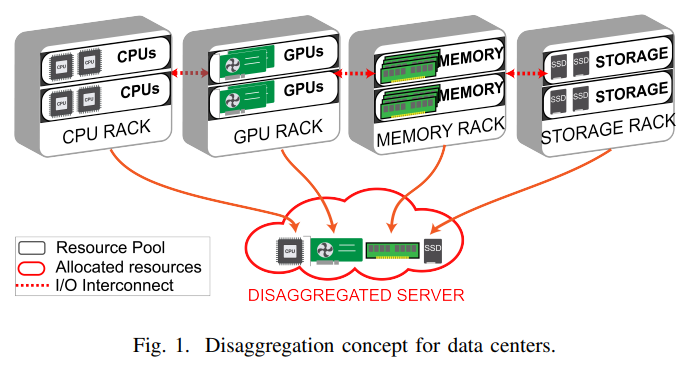We are in the middle of an unprecedented data explosion. Not only are we generating more data, but also consuming more – and it is growing more complex by the day. The key question is: can today’s modern data centers keep up with this surge in demand that will continue unabated as we add more layers of smart devices, IoT, and other emerging technologies to the society?
The prominent solution has been to build hyperconverged data centers that aggregate storage, network and compute resources into a single system. But despite its cost and deployment benefits, hyperconverged infrastructure has scalability limitations. This is where a new paradigm of disaggregated data centers is emerging.
By separating critical data centers and then connecting them via optical interconnect, disaggregated data centers enable more efficient processing of increasingly complex and massive workloads. Doing so has major advantages:
- Greater flexibility
- More scalability
- Improved energy efficiency
- Enhanced cost savings
This is exactly what our future demands. Given that we are living in the fiber age, it is no surprise to see fiber optic interconnect help facilitate this architectural shift towards more efficient, future-proof data centers. But how exactly does optical interconnect make it happen? Let us take a deep dive.
Contents
Data is changing, so must data centers
Greater platform flexibility. Much higher density. More efficient utilization.
All these requirements have pushed the needle on the disaggregation of data centers via the ever-reliable data center optical interconnects. But what is shaping this transformation? The rise of data at levels that have never been seen before. The following statistics from the IEEE 802.3 Ethernet Bandwidth Assessment Report paint a more accurate picture:
- More data: The boom in social media platforms, e-commerce and software
usage is accelerating the data demand significantly. 5G is also opening up new
avenues for end users to consume and generate more data. This means that more
and more businesses and enterprises are acquiring their own hyperscale data
centers to manage various business functions and workloads. They come from the
following:
- Connected devices: Global internet-connected devices to increase to 38 billion by 2025 from the current 29 billion figure
- Increasing traffic per user: 200% bump in the average traffic per user since 2017
- Rise of videos: 82% of the global data consumption is being driven by video, putting further strain on bandwidth
- More complex data: Machine-to-machine communication in the Industry 4.0 paradigm is driving the complexity of data generated, thus shooting up bandwidth and processing demands.
With data scaling up rapidly, so must data centers. This is where data center disaggregation is a modern approach to data center design and management that separates the different components of a data center into distinct units. This allows for greater flexibility and scalability, as well as improved energy efficiency and cost savings.
One key technology that enables data center disaggregation is optical interconnects.
Data center disaggregation – The new paradigm
Strengthening the data center network infrastructure goes a long way to fulfilling the burgeoning demand for data centers to be faster and more efficient.
For the US, which accounts for roughly 40% of the global data center market, fiber optic interconnect and data center disaggregation opens a promising pathway to satisfying staggering levels of data demand. By 2030, the demand for US data centers is expected to cross 35 GW. This is more than double the demand registered in 2022, i.e., 12 GW. In that regard, data center optical interconnect will help the country shore up its data center infrastructure for meeting endless requirements for high bandwidth and low latency.

Image Credit : mckinsey.com – Data center demand
Typically, data centers have been built using racks of servers with consolidated resources for computing, interconnect, etc. However, to serve an application, only a certain percentage of these resources is utilised, leading to a loss in efficiency. This is the chief drawback of the server as a basic unit architecture.

Image Credit : arxiv.org – Disaggregation
In comes disaggregation, which enables reorganization of the data center architecture to leverage compute resources more effectively. Here, a central intelligence unit determines the exact amount of computing, networking and storage resources that a certain job demands. The remaining resources can then be allocated to other jobs. This makes disaggregated data center architecture perfectly positioned for satisfying today’s high bandwidth and low latency requirements.
Optical interconnect: The light at the end of the data explosion tunnel
Optical interconnects, also known as fiber optic interconnects, use fiber optic cabling to transmit data at high speeds over long distances. This technology is well-suited for disaggregated data center applications due to its high bandwidth capacity and low power consumption.
Optical interconnects enable data center disaggregation by allowing for the separation of different components of the data center into distinct units. These units can be connected to each other using optical fibers, which provide high bandwidth and low power consumption. These optical connections form a key part of the fiber deep network, which can help accelerate 5G and FTTH adoption.
Additionally, the wide range of optical interconnect devices and designs allows for the flexible connection and disconnection of different components, such as servers, storage systems, and network switches, as needed. Optical interconnect often comes in the form of pluggable modules, allowing networks to seamlessly upgrade and support 400G, 800G, and 1.6T Ethernet.
The use of optical interconnects also enables the deployment of different types of interconnect configurations, such as rack-to-rack, room-to-room, and building-to-building. This improves reliability and redundancy and allows for greater scalability and flexibility in the data center.
Advantages of data center optical interconnects
- High bandwidth capacity: Optical interconnects provide a high bandwidth capacity, which allows for the efficient transfer of large amounts of data between different components of a data center. This is crucial for data centers that process and store large amounts of data, such as big data and cloud computing centers.
- Low power consumption: Optical interconnects consume less power than traditional copper-based interconnects, which makes them a more energy-efficient option for data centers.
- Increased flexibility and scalability: Data center optical interconnects allow greater flexibility and scalability, as they comprise a wide product range for compatibility across network bandwidths and categories.
- Improved reliability and redundancy: Data center disaggregation enables the use of different types of interconnects for different components, which improves reliability and redundancy. For example, optical interconnects can be used for high-bandwidth applications, while copper-based interconnects can be used for lower-bandwidth applications.
- Cost savings: Optical interconnects are a cost-effective option, as they are less expensive than traditional copper-based interconnects.
As the US ramps up its 5G deployments and continues to expand its data center footprint, the optical interconnect market will continue to grow. At present, the global optical interconnect market is predicted to reach $17.1 billion by 2025, fuelled by the surge in cloud computing, big data, and IoT. North America will account for the largest share of the market.
How STL helps
In conclusion, optical interconnects are an essential technology for data center disaggregation, as they provide high bandwidth capacity, low power consumption, increased flexibility, scalability, and cost savings. As data center companies continue to seek more efficient and cost-effective solutions, optical interconnects are expected to play a significant role in the future of data center design and management in the US.
From Exchanges and OSPs to Distribution & Access and Customer Premises, STL’s world-class optical connectivity devices are tailored to individual network and service provider requirements. That means modern data centers can easily scale up optical interconnect installations, without worrying about compatibility with various networks, tools, and equipment. Here’s to the future-ready, agile, disaggregated data center – made possible with the power of fiber.
Learn more: https://www.stl.tech/optical-interconnect-products/optical-interconnect-kits/















